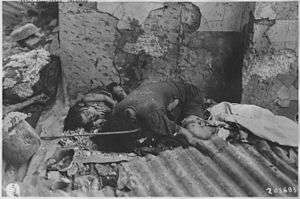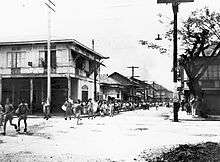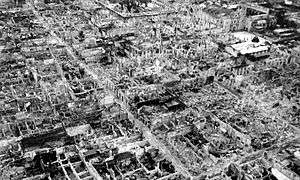Manila massacre
| Manila massacre | |
|---|---|
 Photo of a Filipino woman and child killed by the Japanese forces in Manila. | |
| Location | Manila, Philippines |
| Date | February 3 – March 3, 1945 (EDT) |
Attack type | mass murder, massacre |
| Deaths | 100,000+ (est.) |
| Perpetrators |
Tomoyuki Yamashita, Akira Mutō, Sanji Iwabuchi Imperial Japanese Army |


The Manila massacre (Filipino: Pagpatay sa Maynila) involved atrocities committed against Filipino civilians in the City of Manila, the capital of the Philippines, by Japanese troops during World War II at the Battle of Manila (February 3, 1945 – March 3, 1945). The combined death toll of civilians for the battle of Manila was about 100,000.
The Manila massacre was one of several major war crimes committed by the Imperial Japanese Army, as judged by the postwar military tribunal. The Japanese commanding general, Tomoyuki Yamashita, and his chief of staff Akira Mutō, were held responsible for the massacre and other war crimes in a trial starting October 1945. Yamashita was executed on 23 February 1946 and Mutō on 23 December 1948.
Description
Before the battle, deciding that he would be unable to defend Manila with the forces available to him, and to preserve as large a force as possible in the rural mountain Luzon region of the Philippines, General Tomoyuki Yamashita had insisted on a complete withdrawal of Japanese troops from Manila in January 1945. However, Yamashita's order was ignored by about 10,000 Japanese marines under Rear Admiral Iwabuchi Sanji who chose to remain in Manila. About 4000 Japanese army personnel were unable to leave the city due to the advance of the American and Filipino forces.
In the Battle of Manila from February to March 1945, the United States Army advanced into the city of Manila in order to drive the Japanese out. During lulls in the battle for control of the city, Japanese troops took their anger and frustration out on the civilians in the city. Violent mutilations, rapes, and massacres occurred in schools, hospitals and convents, including San Juan de Dios Hospital, Santa Rosa College, Santo Domingo Church, Manila Cathedral, Paco Church, St. Paul's Convent, and St. Vincent de Paul Church.[1]:113 Dr Antonio Gisbert told of the murder of his father and brother at the Palacio del Gobernador, saying, "I am one of those few survivors, not more than 50 in all out of more than 3000 men herded into Fort Santiago and, two days later, massacred.[1]:110
The Bayview Hotel was used as a designated "rape center".[2] According to testimony at the Yamashita war crimes trial, 400 women and girls were rounded up from Manila's wealthy Ermita district, and submitted to a selection board that picked out the 25 women who were considered most beautiful. These women and girls, many of them 12 to 14 years old, were then taken to the hotel, where Japanese enlisted men and officers took turns raping them.[3]
One Japanese order read, "The Americans who have penetrated into Manila have about 1000 troops, and there are several thousand Filipino soldiers under the Commonwealth Army and the organized guerrillas. Even women and children have become guerrillas."
The combined death toll of civilians for the battle of Manila was about 100,000, most of which was attributed to massacres by Japanese forces. Some historians, citing a higher civilian casualty rate for the entire battle, suggest that 100,000 to 500,000 died as a result of the Manila massacre on its own, exclusive of other causes.[1][4][5][6][7]
General Yamashita's role in the massacre
General Yamashita was opposed to the plan devised by Imperial Headquarters because his soldiers lacked resources. The soldiers under Yamashita’s command were low on ammunition and food. However, he was unable to disobey his superiors and sent approximately 80,000 soldiers to Leyte. Nearly all of his soldiers had died in the Battle of Leyte, and he was forced to move his headquarters from Manila to Saigon. Yamashita had anticipated that U.S. forces would come to the Philippines, so he had to move his headquarters again and evacuate in order to escape the U.S. forces. On January 9, 1945, Yamashita was met by nearly 200,000 U.S. soldiers at Lingayen Gulf. As a result of this operation, nearly 100,000 Filipino civilians were killed by various methods of violence. Unexpectedly, some Filipino casualties were caused by U.S. aerial bombings. Yamashita continued to fight, but his lack of resources and his exposure to disease and sickness led to his capture.
General Yamashita was considered a war criminal for his crimes in Manila. Evidence suggests that General Yamashita was unaware of the crimes committed by Japanese troops in Manila, and that he ultimately did not have control over those troops who committed the atrocities. The morale of his troops was low, and many of the orders he gave were disobeyed. Yamashita had a sense of guilt and failure as a commanding general over the troops under his command. In the end, he took responsibility for the crimes that his troops committed under his command. A group of American military lawyers attempted to defend General Yamashita by appealing to the U.S. Supreme court, but the appeal failed because the appeal was 5 to 2. As a result, Yamashita was sentenced to death by hanging. He was hanged on February 23, 1946 in Manila.[8]
Rev. Peter Fallon SSC
Rev. Peter Fallon SSC, was an Irish missionary priest kidnapped and killed in the Philippines by Japanese forces in 1945 during Battle of Manila in the Second World War.[9] Born in Ballinlass, Dunmore, County Galway, in Ireland, Fallon studied at All Hallows College, Dublin, before joining the Maynooth Mission to China, in Dalgan Park, where he was ordained in 1922. On ordination, he went to Hanyang, China, and was there until 1930. In 1931 he went to the Philippines,[10] to the Malate Church which the Columbans were stationed.[11] Fallon was first Columban parish priest of what then was the town of Misamis (now Ozamiz City).
Fr. Fallon was one of four priests of the Maynooth Mission to Manilla, kidnapped by Japanese Navy forces and killed, along with local parishioners, the other Columbans being Rev John Heneghan, Rev Patrick Kelly, and Rev Joseph Monaghan, during the Battle of Manilla.[12] The four Columbans were taken from the Malate Church (Our Lady of Remedies Parish) to the Syquia apartments around February 10, 1945, and were never seen again.[13] Along with the fifth Columban in Malate, Fr John Lalor, who was killed three days later while helping in makeshift hospital in the Malate School, they are often referred to as the "Manilla Martyrs".[14] In February 1997 there was a monument erected in front of the Malate Church, in the memory of Fallon, Kelly, Monaghan and Heneghan.[15]
See also
Notes
- 1 2 3 Connaughton, R., Pimlott, J., and Anderson, D., 1995, The Battle for Manila, London: Bloomsbury Publishing, ISBN 0891415785
- ↑ "February 1945: The Rape of Manila | INQUIRER.net". Globalnation.inquirer.net. Retrieved 2016-11-17.
- ↑ Manila Girls Relate Horror of Mass Rape, The Milwaukee Journal, 1 November 1945
- ↑ White, Matthew. "Death Tolls for the Man-made Megadeaths of the 20th Century". Users.erols.com. Retrieved 2007-08-01.
- ↑ Khalifa, Hodieb. Nein. Books.google.com. Retrieved 2016-11-17.
- ↑ Dauria, Tom. Within a Presumption of Godlessness. Books.google.com. Retrieved 2016-11-17.
- ↑ "Battle of Manila". Battle of Manila. Retrieved 2016-11-17.
- ↑ Last Words of the Tiger of Malaya, General Yamashita Tomoyuki, The Asia-Pacific Journal Japan Focus
|access-date=requires|url=(help) - ↑ Dail Questions Irish Priests Manilla Dail Debates, www.oireachtas.ie
- ↑ Columban Martyrs www.columbans.eu
- ↑ The Columbans of Malate Malate Catholic Church Official Website
- ↑ Northern Priest Killed by Japanese Irish News, April 4th, 2014
- ↑ Manila Holocaust and Rape www.malacanang.org.ph
- ↑ THE MANILA MASSACRE
- ↑ MANILA PARISH UNVEILS MONUMENT TO WORLD WAR II VICTIMS February 24, 1997.
References
- Taylor, Lawrence. A Trial of Generals. Icarus Press, South Bend IN, 1981
- Quezon, Taylor (7 February 2007). "The Warsaw of Asia: How Manila Was Flattened in WWII". Arab News. Retrieved 25 January 2011.
External links
- WW2DB: The Philippines Campaign
- The Battling Bastards of Bataan
- The Historical Atlas of the Twentieth Century by Matthew White
Coordinates: 15°35′00″N 120°58′00″E / 15.5833°N 120.9667°E